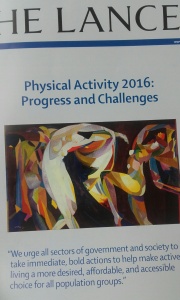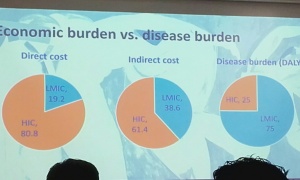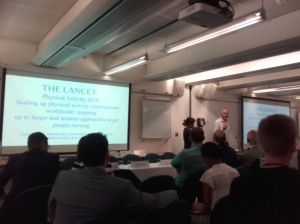Today I attended an event launching a special issue of The Lancet on Physical Activity. It was the second such event, 4 years on from the first. The event was well organised and well attended. So, how did it go?
Judging a book by its cover … yes, it’s a better cover image than last time. Well done there ; )

Pamela Das opened proceedings by warning the audience that this was “not [only] about sport”.
The presenters all spoke well on their areas of expertise. Ding Ding highlighted the enormous economic cost of inactivity (after a paper in 2012 highlighted life years lost to inactivity). She also compared and contrasted the economic and disease burden between low/middle and high income countries. It did make me think that after the medical and economic arguments have been made, it will surely be time to bring discussion of the social to the fore. Next time!

Ulf Ekelund discussed links between PA, sitting time and mortality. A range of interesting questions followed culminating in musing about the differences between squatting and sitting. Pedro Hallal and Rodrigo Reis spoke well about progress over the last 4 years and the potential to “scale up” interventions. This did make me think about the specific lack of published physical activity policy literature, and how there is a need for robust analysis of PA policy processes. This is especially true given Reis pointed out that “political support” is considered by stakeholders both important and very difficult to obtain.

The panel discussion which followed produced some of the more provocative exchanges. Richard Horton warned against being overly positive about the speed of change, and he asked some challenging questions, in the form of “What is the biggest challenge and biggest opportunity?” Here the presenters allowed their passion about PA to be displayed. Pedro Hallal in particular noted that there was not enough “indignation” about the current state of affairs. Interesting stuff. Richard questioned the Sport England term “customer” … “Do you mean people?”
It was incredible to hear Coca Cola referred to in discussion about “toxic” private interests. Nobody in the room disagreed. How the world has changed from Rio 2014, when the ISPAH conference was literally festooned with Coca Cola sponsorship! It was also fascinating to hear from one panellist who was extremely disappointed at the attempts by physical activity advocates to cooperate with Nike and the Designed To Move initiative … saying it did not work at all. His conclusion was that “their interests are not our interests”. Great critical analysis.

Richard Horton concluded by encouraging the audience to be more involved in advocacy, with opportunities for researchers and students to be spokespeople for PA in a variety of advocacy roles. He also noted that we should have an element of humility about our advocacy. People sometimes value things other than “health”, and we all might “trade off” some health for other experiences. It reminded me of what Alan Bairner once said about the physical health benefits accrued from walking. They ‘may well be of secondary importance to the lessons that can be learned from the pedagogies of the street’ (p. 373).
Looking forward to the next one (2020?), I think I understand the reason for publishing the Special Issue just before the Olympic Games. But perhaps the next issue should be moved away from the Olympic month. Using the Olympics to capture attention is one thing, but I suspect it also serves to conflate the issues for many people.
Joe Piggin
Reference:
Bairner, A. (2012). Urban walking and the pedagogies of the street. Sport, Education and Society, 16, 371–384. doi:10.1080/13573322.2011.565968
